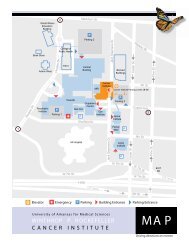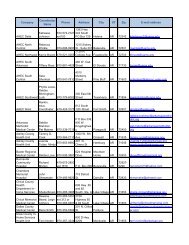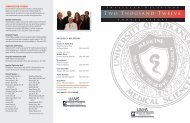Flat epithelial Atypia - UAMS Medical Center
Flat epithelial Atypia - UAMS Medical Center
Flat epithelial Atypia - UAMS Medical Center
- No tags were found...
Create successful ePaper yourself
Turn your PDF publications into a flip-book with our unique Google optimized e-Paper software.
<strong>Flat</strong> Epithelial <strong>Atypia</strong>Richard Owings, M.D.University of Arkansas for <strong>Medical</strong>SciencesDepartment of Pathology
• <strong>Flat</strong> <strong>epithelial</strong> atypia can be a difficult lesion• May be a subtle diagnosis• Lots of changes in the breast• Numerous previous names and differentdescriptions• Patient management is ambiguous.
Why so difficult• Often occurs around definitively neoplasticlesions.• Often occurs in the setting other columnar celland proliferative lesions.• Relative interpretation of “atypia” and “flat”
World Health Organization• <strong>Flat</strong> <strong>epithelial</strong> atypia– “A presumably neoplastic intraductal alterationcharacterized by replacement of the native<strong>epithelial</strong> cells by a single or 3-5 layers of mildlyatypical cells.”
Clinical significance• Low grade non-obligate pre-neoplastic lesion• Association with other lesions– Atypical ductal hyperplasia– Lobular neoplasia– Low grade ductal carcinoma in situ (cribiform andmicropapillary types)– Low grade invasive carcinoma (Tubular carcinoma)• FEA lesions are typically excised followingdiagnosis by biopsy.• Excision may demonstrate a worse lesion.
“At least some columnar cell lesions, particularlyFEA, are neoplastic proliferations that may wellrepresent either a precursor to, or at least theearliest morphologic manifestation of, a lowgrade DCIS as well as a precursor to invasivecarcinoma.”Stuart Schnitt and Laura Collins (2008). Biopsy interpretation of the breast.
Excisions following FEA on CNB• ADH was found in 17.3% (37/214 cases) of“pure” FEA cases on the first set of biopsy levelsby cutting 3 additional levels.• A worse lesion (ADH, DCIS, LN) was found in 23 of35 (67%) follow up excisions after completesubmission.• 14% of patients with FEA only on CNB may haveDCIS or invasive carcinoma (5/35) on excision.• Similar to ADH on CNB.Chivuklua, M., Bhargova, R, Tseng, G, Dabbs, D. Clinicopathologic implications of FEA inCNB specimens of the breast. Anatomic pathology. 2009:131:802-808
Excisions following FEA on CNB• 3/15 (20%) patients with FEA only by CNBwere found to have worse lesions.– 1 was DCIS and 2 were IDC– Not correlated to residual microcalcifications• 6/46 (16%) patients with ADH only by CNBwere found to have DCIS.Anna Ingegnoli, et al. FEA and ADH: Carcinoma Underestimation rate. The BreastJournal, Volume 16 Number 1, 2010 55–59
FEA-Molecular• Clonally and molecularly related to ADH,lobular neoplasia, and low grade tubularcarcinoma• Similar chromosomal aberrations mostcommonly involving chromosomes 11q and16q• FEA colliding or merging into a low grade DCIShas similar chromosomal aberrations
Differential Diagnosis• From a trainee perspective, FEA, columnar celllesions, and ADH are probably the mostdifficult to understand• This is likely due recognizing “atypia”– Separating benign from atypial is difficult– Lots of things are “atypical” (both benign andmalignant– Instead we have to recognize these lesions asneoplastic
“Atypical” looking breastlesions/Differential diagnosis• Myoepthelial hyperplasia• Fibrocystic change (low power cysts)• Usual ductal hyperplasia• Columnar cell lesions without atypia• Apocrine metaplasia• Lactation changes• Blunt duct adenosis• <strong>Flat</strong> ductal carcinoma in situ
Interobserver variability• Most studies have shown good reproducibility– Typically compared after brief tutorial withdigitized images.– Little variability in separating ADH, DCIS, andnormal breast– Most variable lesions were those classified ascolumnar cell lesion with and without atypia.Schnitt SJ. The diagnosis and management of pre-invasive breast disease: flat <strong>epithelial</strong> atypia—classification, pathologic features and clinical significance. Breast Cancer Res2003;5:263 - 8.Tan PH, Ho BC, Selvarajan S, Yap WM, Hanby A. Pathological diagnosis of columnar cell lesions ofthe breast: are there issues of reproducibility? J Clin Pathol 2005;58:705- 9.O’Malley FP, Mohsin SK, Badve S, et al. Interobserver reproducibility in the diagnosis of flat<strong>epithelial</strong> atypia of the breast. Mod Pathol 2006;19:172- 9.
Management• FEA on CNB is usually followed by excision.• Size of the core biopsy– Upgrade rate in cases of ADH is inversely proportionalto core size (14 g to 11 g).• Complete removal of microcalcifications– Adjacent foci of DCIS or invasive carcinoma withoutcalcifications has been documented• Follow up MRI• Clinical features such as age, size of lesion,patient desires
Closing remarks• FEA can be a tricky lesion due in a large part toits history, evolving terminology, and place inthe classification system.• The low grade end of any classification systemcan be difficult• Separating FEA from other proliferative lesion– Over calling benign lesions• Separating more malignant lesions from FEA.– Under calling malignant lesions
Closing remarks
<strong>Flat</strong> Epithelial <strong>Atypia</strong>Richard Owings, M.D.University of Arkansas for <strong>Medical</strong> ScienceLittle Rock, Ar
















